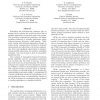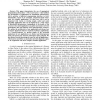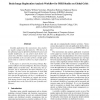CLOUDCOM
2010
Springer
14 years 10 months ago
2010
Springer
Many scientific applications suffer from the lack of a unified approach to support the management and efficient processing of large-scale data. The Twister MapReduce Framework, whi...
103
click to vote
CORR
2010
Springer
15 years 23 days ago
2010
Springer
The proliferation of commercial cloud computing providers has generated significant interest in the scientific computing community. Much recent research has attempted to determine...
104
click to vote
ISCAPDCS
2004
15 years 2 months ago
2004
Scheduling and load-balancing techniques play an integral role in reducing the overall execution time of scientific applications on clustered multi-node systems. The increasing co...
129
click to vote
ESCIENCE
2007
IEEE
15 years 4 months ago
2007
IEEE
This paper demonstrates the use of appropriate ing abstractions
128
Voted
AINA
2009
IEEE
15 years 4 months ago
2009
IEEE
Scientific applications like neuroscience data analysis are usually compute and data-intensive. With the use of the additional capacity offered by distributed resources and suitab...
122
Voted
CCGRID
2007
IEEE
15 years 7 months ago
2007
IEEE
Scientific applications often involve computation intensive workflows and may generate large amount of derived data. In this paper we consider a life cycle, which starts when the ...
ISPASS
2008
IEEE
15 years 7 months ago
2008
IEEE
The floating point portion of the SPEC CPU suite and the HPC Challenge suite are widely recognized and utilized as benchmarks that represent scientific application behavior. In th...
90
Voted
ISPASS
2010
IEEE
15 years 7 months ago
2010
IEEE
—Until recently, most high-end scientific applications have been immune to performance problems caused by NonUniform Memory Access (NUMA). However, current trends in micro-proces...



